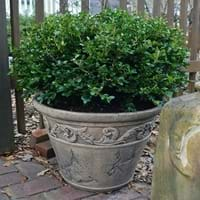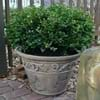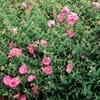Life Span
Perennial
Annual and Perennial
Type
Broadleaf Evergreen
Tender Perennial
Origin
China, Korea
South Africa
Types
Not available
Osteospermum acanthospermum, Osteospermum amplectens, Osteospermum burttianum
Number of Varieties
Not Available
Habitat
Boggy areas, Swamps
Coastal Regions, Sandy areas, Terrestrial
USDA Hardiness Zone
4-9
10-11
AHS Heat Zone
Not Available
Not Available
Sunset Zone
21,22
8, 9, 12, 13, 14, 15, 16, 17, 18, 19, 20, 21, 22, 23, 24
Habit
Oval or Rounded
Clump-Forming
Flower Color
Yellow green
White, Purple, Blue Violet
Flower Color Modifier
Bicolor
Bicolor
Fruit Color
Not Available
Not Available
Leaf Color in Spring
Green, Dark Green
Green
Leaf Color in Summer
Dark Green
Green
Leaf Color in Fall
Dark Green
Green, Blue Green
Leaf Color in Winter
Dark Green
Light Green
Leaf Shape
Pinnate
Irregular
Plant Season
Spring, Summer, Fall, Winter
Spring, Summer, Fall
Sunlight
Full Sun, Partial Sun
Full Sun, Partial Sun
Type of Soil
Loam, Sand
Loam
The pH of Soil
Acidic, Neutral
Neutral
Soil Drainage
Well drained
Well drained
Bloom Time
Late Spring
Late Spring, Early Summer, Summer, Late Summer, Early Fall, Fall
Tolerances
Not Available
Drought
Where to Plant?
Container, Ground, Pot
Container
How to Plant?
Cuttings, Seedlings
Seedlings, Stem Cutting
Plant Maintenance
Medium
Medium
Watering Requirements
Keep ground moist, Keep the Soil well drained, Requires regular watering
Do Not over Water, Keep ground moist
In Summer
Lots of watering
Lots of watering
In Spring
Moderate
Moderate
In Winter
Average Water
Average Water
Soil pH
Acidic, Neutral
Neutral
Soil Type
Loam, Sand
Loam
Soil Drainage Capacity
Well drained
Well drained
Sun Exposure
Full Sun, Partial Sun
Full Sun, Partial Sun
Pruning
Prune back the growing tips, Prune to stimulate growth, Remove damaged leaves, Remove dead branches, Remove dead leaves
Remove damaged leaves, Remove dead branches, Remove dead leaves
Fertilizers
10-10-10 diluted liquid fertilizer, Any balanced general purpose fertilizer
All-Purpose Liquid Fertilizer
Pests and Diseases
Leafminer, Mites, Nematodes, Psyllids
Red blotch
Plant Tolerance
Drought
Drought
Flowers
Insignificant
Showy
Flower Petal Number
Single
Single
Foliage Texture
Fine
Medium
Foliage Sheen
Glossy
Not Available
Attracts
Flying insects, Insects
Bees, Birds, Butterflies
Allergy
Itchiness, Skin irritation
Not Available
Aesthetic Uses
Bonsai, Decorating walls, Landscape Designing, Mass in beds, Mixed Border, Showy Purposes, Used for decorating walls, fences, gates, hedges, etc., Used for making hedges
Beautification, Showy Purposes
Beauty Benefits
Not Available
Not Available
Environmental Uses
Air purification, Food for animals, Food for birds
Air purification
Medicinal Uses
Not Available
Not Applicable
Part of Plant Used
Not Available
Flowers
Other Uses
Used as Ornamental plant, Used for Landscaping
Used as Ornamental plant
Used As Indoor Plant
No
No
Used As Outdoor Plant
Yes
Yes
Garden Design
Container, Edging, Foundation, Hedges, Rock Garden, Wall
Bedding Plant, Container, Cutflower, Foundation, Groundcover, Hanging Basket, Mixed Border, Rock Garden / Wall
Botanical Name
Buxus microphylla
OSTEOSPERMUM fruticosum
Common Name
Korean boxwood
Shrubby Daisybush, Trailing African Daisy
In Hindi
Korean Boxwood
Blue Eyed Daisy Plant
In German
Koreanisch Boxwood
Blue Eyed Daisy Pflanze
In French
Boxwood coréenne
Blue Eyed Daisy Plante
In Spanish
Buxus microphylla
Planta observada azul de la margarita
In Greek
Κορέας Πυξάρι
Μπλε Eyed Daisy Φυτών
In Portuguese
Boxwood coreana
Planta da margarida de olhos azuis
In Polish
Koreański Bukszpan
Blue Eyed Daisy roślin
In Latin
Korean Boxwood
Daisy Blue Eyed Planta
Phylum
Tracheophyta
Magnoliophyta
Class
Magnoliopsida
Magnoliopsida
Family
Buxaceae
Asteraceae
Clade
Angiosperms, Eudicots
Angiosperms, Asterids, Eudicots
Tribe
Not Available
Calenduleae
Subfamily
Not Available
Asteroideae
Importance of Korean Boxwood and Blue Eyed Daisy Plant
Want to have the most appropriate plant for your garden? You might want to know the importance of Korean Boxwood and Blue Eyed Daisy Plant. Basically, these two plants vary in many aspects. Compare Korean Boxwood and Blue Eyed Daisy Plant as they differ in many characteristics such as their life, care, benefits, facts, etc. Every gardener must at least have the slightest clue about the plants he wants to plant in his garden. Compare their benefits, which differ in many ways like facts and uses. The medicinal use of Korean Boxwood is Not Available whereas of Blue Eyed Daisy Plant is Not Applicable. Korean Boxwood has beauty benefits as follows: Not Available while Blue Eyed Daisy Plant has beauty benefits as follows: Not Available.
Compare Facts of Korean Boxwood vs Blue Eyed Daisy Plant
How to choose the best garden plant for your garden depending upon its facts? Here garden plant comparison will help you to solve this query. Compare the facts of Korean Boxwood vs Blue Eyed Daisy Plant and know which one to choose. As garden plants have benefits and other uses, allergy is also a major drawback of plants for some people. Allergic reactions of Korean Boxwood are Itchiness and Skin irritation whereas of Blue Eyed Daisy Plant have Not Available respectively. Having a fruit bearing plant in your garden can be a plus point of your garden. Korean Boxwood has no showy fruits and Blue Eyed Daisy Plant has no showy fruits. Also Korean Boxwood is not flowering and Blue Eyed Daisy Plant is not flowering . You can compare Korean Boxwood and Blue Eyed Daisy Plant facts and facts of other plants too.





